Compact Flexible Planar Antennas for Biomedical Applications: Insight into Materials and Systems Design
Abstract
:1. Introduction
1.1. Selection of Materials
1.2. Human Body Interaction with the Antenna
1.3. Antenna Performance in Close Proximity to Human Body
1.4. Structural Variation of Antenna
1.5. Antenna Performance under Wet and Humid Conditions
2. Material Selection
2.1. Non-Conductive Materials
2.2. Conductive Materials
3. Types of Antennas for Biomedical Applications
3.1. Wearable Antenna
3.2. Textile Antenna
3.3. Polymer Based Antenna
3.4. Antennas for Microwave Imaging
4. Conclusions
- Increasing the accuracy and effectiveness of the present measurement and manufacturing processes;
- Releasing new yarns and conductive textiles on the market that have increased conductivity or decreased resistance;
- Introducing new flexible materials for clothing that can be embroidered or new suggested production methods;
- Introducing novel body-operated antenna sensors based on substrate materials used for various applications.
Author Contributions
Funding
Institutional Review Board Statement
Informed Consent Statement
Data Availability Statement
Conflicts of Interest
References
- Venkatachalam, D.; Govindasamy, M. A miniaturized planar antenna with defective ground structure for UWB applications. IEICE Electron. Express 2019, 16, 20190242. [Google Scholar] [CrossRef]
- Dinesh, V.; Murugesan, G. A CPW-Fed hexagonal antenna with fractal elements for UWB applications. Int. J. Appl. Math. Inf. Sci. 2019, 13, 73–79. [Google Scholar] [CrossRef]
- Hassan, A.; Ali, S.; Bae, J.; Lee, C.H. All printed antenna based on silver nanoparticles for 1.8 GHz applications. Appl. Phys. A 2016, 122, 768. [Google Scholar] [CrossRef]
- Singh, R.; Kumari, P.; Rawat, S.; Singh, P.; Ray, K. Design and performance analysis of low profile miniaturized MSPAs for body centric wireless communication in ISM band. Int. J. Comput. Inf. Syst. Ind. Manag. Appl. 2017, 9, 153–161. [Google Scholar]
- Azeez, H.I.; Yang, H.-C.; Chen, W.-S. Wearable Triband E-Shaped Dipole Antenna with Low SAR for IoT Applications. Electronics 2019, 8, 665. [Google Scholar] [CrossRef]
- Christina, G. Review on Wearable Antennas and their Applications. IRO J. Sustain. Wirel. Syst. 2021, 3, 259–265. [Google Scholar] [CrossRef]
- Tuovinen, T.; Berg, M.; Yazdandoost, K.Y.; Iinatti, J. Ultra wideband loop antenna on contact with human body tissues. IET Microw. Antennas Propag. 2013, 7, 588–596. [Google Scholar] [CrossRef]
- Al-Haddad, M.; Jamel, N.; Nordin, A.N. Flexible antenna: A review of design, materials, fabrication, and applications. J. Phys. Conf. Ser. 2021, 1878, 012068. [Google Scholar] [CrossRef]
- Abolade, J.O.; Konditi, D.B.; Dharmadhikary, V.M. Comparative study of textile material characterization techniques for wearable antennas. Results Mater. 2021, 9, 100168. [Google Scholar] [CrossRef]
- El Atrash, M.; Abdalgalil, O.F.; Mahmoud, I.S.; Abdalla, M.A.; Zahran, S.R. Wearable high gain low SAR antenna loaded with backed all-textile EBG for WBAN applications. IET Microw. Antennas Propag. 2020, 14, 791–799. [Google Scholar] [CrossRef]
- Dalfiah, J.; Ishwariya, M.; Kousalya, T. Design of Wearable Textile Antenna for Biomedical WBAN Application Using ISM Band; EasyChair: Stockport, UK, 2021. [Google Scholar]
- Mandal, B.; Parui, S. Wearable tri-band SIW based antenna on leather substrate. Electron. Lett. 2015, 51, 1563–1564. [Google Scholar] [CrossRef]
- Sreemathy, R.; Hake, S.; Gaikwad, S.V.; Saw, S.K.; Behera, S. Design, Analysis and Fabrication of Dual Frequency Distinct Bandwidth Slot Loaded Wash Cotton Flexible Textile Antenna for Ism Band Applications. Prog. Electromagn. Res. M 2022, 109, 191–203. [Google Scholar] [CrossRef]
- Rahim, H.A.; Malek, F.; Adam, I.; Ahmad, S.; Hashim, N.B.; Hall, P.S. Design and simulation of a wearable textile monopole antenna for body centric wireless communications. In Proceedings of the Progress in Electromagnetics Research Symposium (PIERS), Moscow, Russia, 19–23 August 2012. [Google Scholar]
- Kaur, H.; Chawla, P. Design and performance analysis of wearable antenna for ISM band applications. Int. J. Electron. 2022, 110, 986–1005. [Google Scholar] [CrossRef]
- Le, T.T.; Yun, T.-Y. Wearable Dual-Band High-Gain Low-SAR Antenna for Off-Body Communication. IEEE Antennas Wirel. Propag. Lett. 2021, 20, 1175–1179. [Google Scholar] [CrossRef]
- Hamza, A.R.; Al-Hindawi, A.M.J. The effecting of human body on slotted monopole antenna in wearable communications. J. Eng. 2021, 27, 27–43. [Google Scholar] [CrossRef]
- Lin, X.; Chen, Y.; Gong, Z.; Seet, B.-C.; Huang, L.; Lu, Y. Ultrawideband Textile Antenna for Wearable Microwave Medical Imaging Applications. IEEE Trans. Antennas Propag. 2020, 68, 4238–4249. [Google Scholar] [CrossRef]
- Liu, W.; Zhang, K.; Li, J.; Yan, S. A Wearable Tri-Band Half-Mode Substrate Integrated Waveguide Antenna. IEEE Antennas Wirel. Propag. Lett. 2021, 20, 2501–2505. [Google Scholar] [CrossRef]
- Lakrit, S.; Das, S.; Madhav, B.T.P.; Babu, K.V. An octagonal star shaped flexible UWB antenna with band-notched charac-teristics for WLAN applications. J. Instrum. 2020, 15, P02021. [Google Scholar] [CrossRef]
- Zhu, S.; Langley, R. Dual-Band Wearable Textile Antenna on an EBG Substrate. IEEE Trans. Antennas Propag. 2009, 57, 926–935. [Google Scholar] [CrossRef]
- Akbarpour, A.; Chamaani, S. Ultrawideband Circularly Polarized Antenna for Near-Field SAR Imaging Applications. IEEE Trans. Antennas Propag. 2020, 68, 4218–4228. [Google Scholar] [CrossRef]
- Wang, J.C.; Lim, E.G.; Leach, M.; Wang, Z.; Man, K.L.; Huang, Y. Review of wearable antennas for WBAN applications. Int. J. Comput. Sci 2016, 43, 474–480. [Google Scholar]
- Ali, U.; Ullah, S.; Shafi, M.; Shah, S.A.; Shah, I.A.; Flint, J.A. Design and comparative analysis of conventional and metamaterial-based textile antennas for wearable applications. Int. J. Numer. Model. Electron. Networks, Devices Fields 2019, 32, e2567. [Google Scholar] [CrossRef]
- Rahman, N.H.A.; Yamada, Y.; Nordin, M.S.A. Analysis on the Effects of the Human Body on the Performance of Electro-Textile Antennas for Wearable Monitoring and Tracking Application. Materials 2019, 12, 1636. [Google Scholar] [CrossRef] [PubMed]
- Zhang, J.; Yan, S.; Vandenbosch, G.A.E. A Miniature Feeding Network for Aperture-Coupled Wearable Antennas. IEEE Trans. Antennas Propag. 2017, 65, 2650–2654. [Google Scholar] [CrossRef]
- Ashyap, A.Y.I.; Dahlan, S.H.; Abidin, Z.Z.; Kamarudin, M.R.; Majid, H.A.; Alduais, N.A.M.; Dahri, M.H.; Alhandi, S.A. C-shaped antenna based artificial magnetic conductor structure for wearable IoT healthcare devices. Wirel. Networks 2021, 27, 4967–4985. [Google Scholar] [CrossRef]
- Savci, H.; Sajjad, H.; Sana, K.; Kaburcuk, F. Analysis of a compact multi-band textile antenna for wban and wlan applications. Balk. J. Electr. Comput. Eng. 2021, 9, 255–260. [Google Scholar] [CrossRef]
- Sun, Y.; Cheung, S.; Yuk, T. Design of A Textile UWB Antenna with Stable Performance for Body-centric Wireless Communications. IET Microw. Antennas Propag. 2014, 8, 1363–1375. [Google Scholar] [CrossRef]
- Ghaffar, A.; Awan, W.A.; Hussain, N.; Ahmad, S.; Li, X.J. A Compact Dual-Band Flexible Antenna for Applications at 900 and 2450 MHz. Prog. Electromagn. Res. Lett. 2021, 99, 83–91. [Google Scholar] [CrossRef]
- Priya, A.; Kumar, A.; Chauhan, B. A Review of Textile and Cloth Fabric Wearable Antennas. Int. J. Comput. Appl. 2015, 116, 1–5. [Google Scholar] [CrossRef]
- Gharbi, M.E.; Fernández-García, R.; Ahyoud, S.; Gil, I. A Review of Flexible Wearable Antenna Sensors: Design, Fabrication Methods, and Applications. Materials 2020, 13, 3781. [Google Scholar] [CrossRef]
- Bharadwaj, R.; Koul, S.K. Wearable UWB Technology for Daily Physical Activity Tracking, Detection, and Classification. IEEE Sens. J. 2022, 22, 20684–20694. [Google Scholar] [CrossRef]
- Zahran, S.R.; Abdalla, M.A.; Gaafar, A. New thin wide-band bracelet-like antenna with low SAR for on-arm WBAN appli-cations. IET Microw. Antennas Propag. 2019, 13, 1219–1225. [Google Scholar] [CrossRef]
- Mao, C.X.; Zhou, Y.; Wu, Y.; Soewardiman, H.; Werner, D.H.; Jur, J.S. Low-Profile Strip-Loaded Textile Antenna with Enhanced Bandwidth and Isolation for Full-Duplex Wearable Applications. IEEE Trans. Antennas Propag. 2020, 68, 6527–6537. [Google Scholar] [CrossRef]
- Dash, R.K.; Saha, P.B.; Ghoshal, D.; Palai, G. Fractal slot loaded compact wearable button antenna for IOT and X-band ap-plications. Wirel. Netw. 2023, 29, 589–605. [Google Scholar] [CrossRef]
- Bhattacharjee, S.; Mitra, M.; Chaudhuri, S.R.B. An Effective Sar Reduction Technique of a Compact Meander Line Antenna for Wearable Applications. Prog. Electromagn. Res. M 2017, 55, 143–152. [Google Scholar] [CrossRef]
- Hsiao, Y.-T.; Tuan, S.-C.; Chou, H.-T.; Wang, J.-S. Applications of Shielding Techniques to Enhance the Antenna Performance of Mobile Communications and Reduce SAR Induction in the Human Head. Electromagnetics 2005, 25, 343–361. [Google Scholar] [CrossRef]
- Chan, K.H.; Chow, K.M.; Fung, L.C.; Leung, S.W. Effects of using conductive materials for SAR reduction in mobile phones. Microw. Opt. Technol. Lett. 2004, 44, 140–144. [Google Scholar] [CrossRef]
- Haridim, M. Use of rod reflectors for SAR reduction in human head. IEEE Trans. Electromagn. Compat. 2015, 58, 40–46. [Google Scholar] [CrossRef]
- Bal, K.; Kothari, V. Measurement of dielectric properties of textile materials and their applications. Indian J. Fibre Textile Res. 2009, 34, 191–199. [Google Scholar]
- Patel, T.; Sahoo, M. Design issues of wearable antennas. Int. J. Sci. Res. 2016, 5, 2015–2017. [Google Scholar]
- Kirtania, S.G.; Elger, A.W.; Hasan, M.R.; Wisniewska, A.; Sekhar, K.; Karacolak, T.; Sekhar, P.K. Flexible Antennas: A Review. Micromachines 2020, 11, 847. [Google Scholar] [CrossRef] [PubMed]
- Ashyap, A.Y.I.; Bin Dahlan, S.H.; Abidin, Z.Z.; Abbasi, M.I.; Kamarudin, M.R.; Majid, H.A.; Dahri, M.H.; Jamaluddin, M.H.; Alomainy, A. An Overview of Electromagnetic Band-Gap Integrated Wearable Antennas. IEEE Access 2020, 8, 7641–7658. [Google Scholar] [CrossRef]
- Wagih, M.; Wei, Y.; Beeby, S. Flexible 2.4 GHz Node for Body Area Networks with a Compact High-Gain Planar Antenna. IEEE Antennas Wirel. Propag. Lett. 2018, 18, 49–53. [Google Scholar] [CrossRef]
- Bashir, S. Design and Synthesis of non Uniform High Impedance Surface Based Wearable Antennas. Ph.D. Thesis, Department of Electronics Engineering, Loughborough University, Loughborough, UK, 2009. [Google Scholar]
- Ali, U.; Ullah, S.; Kamal, B.; Matekovits, L.; Altaf, A. Design, Analysis and Applications of Wearable Antennas: A Review. IEEE Access 2023, 11, 14458–14486. [Google Scholar] [CrossRef]
- Tsolis, A.; Whittow, W.G.; Alexandridis, A.A.; Vardaxoglou, J.C. Embroidery and Related Manufacturing Techniques for Wearable Antennas: Challenges and Opportunities. Electronics 2014, 3, 314–338. [Google Scholar] [CrossRef]
- Salvado, R.; Loss, C.; Gonçalves, R.; Pinho, P. Textile Materials for the Design of Wearable Antennas: A Survey. Sensors 2012, 12, 15841–15857. [Google Scholar] [CrossRef]
- Haerinia, M.; Noghanian, S. A Printed Wearable Dual-Band Antenna for Wireless Power Transfer. Sensors 2019, 19, 1732. [Google Scholar] [CrossRef]
- Naranjo-Hernández, D.; Reina-Tosina, J.; Roa, L.M. Lessons Learned about the Design and Active Characterization of On-Body Antennas in the 2.4 GHz Frequency Band. Sensors 2019, 20, 224. [Google Scholar] [CrossRef]
- Liu, K.; Sun, D.; Su, T.; Zheng, X.; Li, C. Design of Flexible Multi-Band Miniature Antenna Based on Minkowski Fractal Structure and Folding Technique for Miniature Wireless Transmission System. Electronics 2023, 12, 3059. [Google Scholar] [CrossRef]
- Abdulzahra, D.H.; Alnahwi, F.; Abdullah, A.S.; Al-Yasir, Y.I.A.; Abd-Alhameed, R.A. A Miniaturized Triple-Band Antenna Based on Square Split Ring for IoT Applications. Electronics 2022, 11, 2818. [Google Scholar] [CrossRef]
- Rahimi, M.; Zarrabi, F.B.; Ahmadian, R.; Mansouri, Z.; Keshtkar, A. Miniaturization of Antenna for Wireless Application with Difference Metamaterial Structures. Prog. Electromagn. Res. 2014, 145, 19–29. [Google Scholar] [CrossRef]
- Mingle, S.; Kampouridou, D.; Feresidis, A. Multi-Layer Beam Scanning Leaky Wave Antenna for Remote Vital Signs Detection at 60 GHz. Sensors 2023, 23, 4059. [Google Scholar] [CrossRef]
- Marasco, I.; Niro, G.; Demir, S.M.; Marzano, L.; Fachechi, L.; Rizzi, F.; Demarchi, D.; Motto Ros, P.; D’Orazio, A.; Grande, M.; et al. Wearable Heart Rate Monitoring Device Communicating in 5G ISM Band for IoHT. Bioengineering 2023, 10, 113. [Google Scholar] [CrossRef]
- Seneviratne, S.; Hu, Y.; Nguyen, T.; Lan, G.; Khalifa, S.; Thilakarathna, K.; Hassan, M.; Seneviratne, A. A Survey of Wearable Devices and Challenges. IEEE Commun. Surv. Tutor. 2017, 19, 2573–2620. [Google Scholar] [CrossRef]
- Dakir, R.; Zbitou, J.; Mouhsen, A.; Tribak, A.; Sanchez, A.M.; Latrach, M. A new compact and miniaturized multiband uni-planar CPW-fed Monopole antenna with T-slot inverted for multiple wireless applications. Int. J. Microw. Wirel. Technol. 2017, 9, 1541–1545. [Google Scholar] [CrossRef]
- Mandal, B.; Chatterjee, A.; Parui, S.K. A wearable button antenna with FSS superstrate for WLAN health care applications. In Proceedings of the 2014 IEEE MTT-S International Microwave Workshop Series on RF and Wireless Technologies for Biomedical and Healthcare Applications (IMWS-Bio2014), London, UK, 8–10 December 2014. [Google Scholar]
- Karthikeya, G.S.; Devaiah, K.K.; Sharma, R.S.G.; Patel, M.H.B.; Mandi, N.R.; Thyagaraj, T. Wearable button antenna array for V band application. In Proceedings of the 2016 IEEE 5th Asia-Pacific Conference on Antennas and Propagation (APCAP), Kaohsiung, Taiwan, 26–29 July 2016. [Google Scholar]
- Zhang, J.; Yan, S.; Hu, X.; Vandenbosch, G.A. Aperture-coupled wearable antenna with miniature feeding network. In Proceedings of the 2017 11th European Conference on Antennas and Propagation (EUCAP), Paris, France, 19–24 March 2017. [Google Scholar]
- Casula, G.A.; Montisci, G.J.E. A design rule to reduce the human body effect on wearable PIFA antennas. Electronics 2019, 8, 244. [Google Scholar] [CrossRef]
- Occhiuzzi, C.; Cippitelli, S.; Marrocco, G. Modeling, Design and Experimentation of Wearable RFID Sensor Tag. IEEE Trans. Antennas Propag. 2010, 58, 2490–2498. [Google Scholar] [CrossRef]
- Lin, M.-H.; Chiu, C.-W. Human-body effects on the design of card-type UHF RFID tag antennas. In Proceedings of the 2011 IEEE International Symposium on Antennas and Propagation (APSURSI), Spokane, WA, USA, 3–8 July 2011. [Google Scholar]
- Lin, C.H.; Saito, K.; Takahashi, M.; Ito, K. A compact planar inverted-F antenna for 2.45 GHz on-body communications. IEEE Trans. Antennas Propag. 2012, 60, 4422–4426. [Google Scholar] [CrossRef]
- Kadry, M.; El Atrash, M.; Abdalla, M.A. Design of an ultra-thin compact flexible dual-band antenna for wearable applications. In Proceedings of the 2018 IEEE International Symposium on Antennas and Propagation & USNC/URSI National Radio Science Meeting, Boston, MA, USA, 8–13 July 2018. [Google Scholar]
- Ejaz, A.; Jabeen, I.; Khan, Z.U.; Alomainy, A.; Aljaloud, K.; Alqahtani, A.H.; Hussain, N.; Hussain, R.; Amin, Y. A High Per-formance All-Textile Wearable Antenna for Wristband Application. Micromachines 2023, 14, 1169. [Google Scholar] [CrossRef] [PubMed]
- Bait-Suwailam, M.M.; Labiano, I.I.; Alomainy, A. Impedance Enhancement of Textile Grounded Loop Antenna Using High-Impedance Surface (HIS) for Healthcare Applications. Sensors 2020, 20, 3809. [Google Scholar] [CrossRef]
- Ashyap, A.Y.; Abidin, Z.Z.; Dahlan, S.H.; Majid, H.A.; Waddah, A.; Kamarudin, M.R.; Oguntala, G.A.; Abd-Alhameed, R.A.; Noras, J.M. Inverted E-Shaped Wearable Textile Antenna for Medical Applications. IEEE Access 2018, 6, 35214–35222. [Google Scholar] [CrossRef]
- Chen, S.J.; Kaufmann, T.; Fumeaux, C. Wearable textile microstrip patch antenna for multiple ISM band communications. In Proceedings of the 2013 IEEE Antennas and Propagation Society International Symposium (APSURSI), Orlando, FL, USA, 7–13 July 2013. [Google Scholar]
- Santas, J.; Alomainy, A.; Hao, Y.H.Y. Textile antennas for on-body communications: Techniques and properties. In Proceedings of the 2nd European Conference on Antennas and Propagation (EuCAP 2007), Edinburgh, UK, 11–16 November 2007. [Google Scholar]
- Mantash, M.; Tarot, A.-C.; Collardey, S.; Mahdjoubi, K. Investigation of Flexible Textile Antennas and AMC Reflectors. Int. J. Antennas Propag. 2012, 2012, 236505. [Google Scholar] [CrossRef]
- Rahim, H.A.; Abdulmalek, M.; Soh, P.J.; Vandenbosch, G.A.E. Evaluation of a broadband textile monopole antenna performance for subject-specific on-body applications. Appl. Phys. A 2017, 123, 97. [Google Scholar] [CrossRef]
- Chen, S.J.; Ranasinghe, D.C.; Fumeaux, C. A Robust Snap-On Button Solution for Reconfigurable Wearable Textile Antennas. IEEE Trans. Antennas Propag. 2018, 66, 4541–4551. [Google Scholar] [CrossRef]
- Casula, G.A.; Michel, A.; Nepa, P.; Montisci, G.; Mazzarella, G. Robustness of Wearable UHF-Band PIFAs to Human-Body Proximity. IEEE Trans. Antennas Propag. 2016, 64, 2050–2055. [Google Scholar] [CrossRef]
- Casula, G.A.; Montisci, G.; Michel, A.; Nepa, P. Robustness of complementary wearable ungrounded antennas with respect to the human body. J. Electromagn. Waves Appl. 2017, 31, 1685–1697. [Google Scholar] [CrossRef]
- Zhu, J.; Fox, J.J.; Yi, N.; Cheng, H. Structural Design for Stretchable Microstrip Antennas. ACS Appl. Mater. Interfaces 2019, 11, 8867–8877. [Google Scholar] [CrossRef]
- Sharma, P.K.; Chung, J.-Y. Evaluation of Polydimethylsiloxane (PDMS) as a Substrate for the Realization of Flexible/Wearable Antennas and Sensors. Micromachines 2023, 14, 735. [Google Scholar] [CrossRef]
- Yin, A.; Zhang, C.; Luo, J.; Liu, J.; Ren, Z.-Q.; Wang, Y.X.; Ye, Y.; Yin, R.; Feng, Q.; Chen, Y.Y.; et al. A highly sensitive and miniaturized wearable antenna based on MXene films for strain sensing. Mater. Adv. 2022, 4, 917–922. [Google Scholar] [CrossRef]
- NajafiKhoshnoo, S.; Kim, T.; Tavares-Negrete, J.A.; Pei, X.; Das, P.; Lee, S.W.; Rajendran, J.; Esfandyarpour, R. A 3D Na-nomaterials-Printed Wearable, Battery-Free, Biocompatible, Flexible, and Wireless pH Sensor System for Real-Time Health Monitoring. Adv. Mater. Technol. 2023, 8, 2201655. [Google Scholar] [CrossRef]
- Conti, S.; Nepa, F.; Di Pascoli, S.; Brunetti, I.; Pimpolari, L.; Song, X.; Parvez, K.; Lomeri, H.J.; De Rossi, F.; Lucarelli, G.; et al. Hybrid Flexible NFC Sensor on Paper. IEEE J. Flex. Electron. 2023, 2, 4–10. [Google Scholar] [CrossRef]
- Ren, L.-F.; Xia, F.; Shao, J.; Zhang, X.; Li, J. Experimental investigation of the effect of electrospinning parameters on properties of superhydrophobic PDMS/PMMA membrane and its application in membrane distillation. Desalination 2017, 404, 155–166. [Google Scholar] [CrossRef]
- Abbas, S.M.; Desai, S.C.; Esselle, K.P.; Volakis, J.L.; Hashmi, R.M. Design and Characterization of a Flexible Wideband Antenna Using Polydimethylsiloxane Composite Substrate. Int. J. Antennas Propag. 2018, 2018, 4095765. [Google Scholar] [CrossRef]
- Sharma, P.K.; Gupta, N. A CPW-Fed Circular SRR-Inspired Flexible Antenna Using Polydimethylsiloxane (PDMS) Substrate for WLAN and WBAN Applications. IEEE J. Flex. Electron. 2022, 1, 39–46. [Google Scholar] [CrossRef]
- Raad, H.K.; Al-Rizzo, H.M.; Abbosh, A.I.; Hammoodi, A.I. A Compact Dual Band Polyimide Based Antenna for Wearable and Flexible Telemedicine Devices. Prog. Electromagn. Res. C 2016, 63, 153–161. [Google Scholar] [CrossRef]
- Elmobarak, H.A.; Rahim, S.K.A.; Castel, X.; Himdi, M. Flexible conductive fabric/E-glass fibre composite ultra-wideband antenna for future wireless networks. IET Microwaves, Antennas Propag. 2019, 13, 455–459. [Google Scholar] [CrossRef]
- Chang, X.L.; Chee, P.S.; Lim, E.H.; Nguyen, N.-T. Frequency Reconfigurable Smart Antenna with Integrated Electroactive Polymer for Far-Field Communication. IEEE Trans. Antennas Propag. 2021, 70, 856–867. [Google Scholar] [CrossRef]
- Miranda, I.; Souza, A.; Sousa, P.; Ribeiro, J.; Castanheira, E.M.S.; Lima, R.; Minas, G. Properties and Applications of PDMS for Biomedical Engineering: A Review. J. Funct. Biomater. 2021, 13, 2. [Google Scholar] [CrossRef]
- Simorangkir, R.B.; Kiourti, A.; Esselle, K.P. UWB Wearable Antenna with a Full Ground Plane Based on PDMS-Embedded Conductive Fabric. IEEE Antennas Wirel. Propag. Lett. 2018, 17, 493–496. [Google Scholar] [CrossRef]
- Janapala, D.K.; Nesasudha, M.; Neebha, T.M.; Kumar, R. Design and Development of Flexible PDMS Antenna for UWB-WBAN Applications. Wirel. Pers. Commun. 2021, 122, 3467–3483. [Google Scholar] [CrossRef]
- Zhang, G.; Sun, Y.; Qian, B.; Gao, H.; Zuo, D. Experimental study on mechanical performance of polydimethylsiloxane (PDMS) at various temperatures. Polym. Test. 2020, 90, 106670. [Google Scholar] [CrossRef]
- Khan, M.U.A.; Raad, R.; Tubbal, F.; Theoharis, P.I.; Liu, S.; Foroughi, J. Bending Analysis of Polymer-Based Flexible Antennas for Wearable, General IoT Applications: A Review. Polymers 2021, 13, 357. [Google Scholar] [CrossRef] [PubMed]
- Al-Sehemi, A.; Al-Ghamdi, A.; Dishovsky, N.; Atanasov, N.; Atanasova, G. A Flexible Miniature Antenna for Body-Worn Devices: Design and Transmission Performance. Micromachines 2023, 14, 514. [Google Scholar] [CrossRef]
- Ahadi, M.; Roudjane, M.; Dugas, M.-A.; Miled, A.; Messaddeq, Y. Wearable Sensor Based on Flexible Sinusoidal Antenna for Strain Sensing Applications. Sensors 2022, 22, 4069. [Google Scholar] [CrossRef]
- Dinesh, V.; Murugesan, G. A Compact Stair Case Monopole UWB Antenna for Radar Applications. In Proceedings of the 2018 International Conference on Intelligent Computing and Communication for Smart World (I2C2SW), Erode, India, 14–15 December 2018. [Google Scholar]
- Vijayalakshmi, J.; Dinesh, V. Design and Challenges. Design of Compact Ultra-Wideband (UWB) Antennas for Microwave Imaging Applications. In Next-Generation Antennas: Advances and Challenges; Scrivener Publishing: Beverly, MA, USA, 2021; pp. 221–249. [Google Scholar]
- Dioline, S.; Arunkumar, M.; Dinesh, V.; Nagarjuna, T.; Karuppanan, S. Radiology: Clinical trials implemented by composite test-beds via MVDR beamformer system. Mater. Today Proc. 2021, 46, 4295–4297. [Google Scholar] [CrossRef]
- Zerrad, F.-E.; Taouzari, M.; Makroum, E.M.; El Aoufi, J.; Qanadli, S.D.; Karaaslan, M.; Al-Gburi, A.J.A.; Zakaria, Z. Microwave Imaging Approach for Breast Cancer Detection Using a Tapered Slot Antenna Loaded with Parasitic Components. Materials 2023, 16, 1496. [Google Scholar] [CrossRef] [PubMed]
- Martínez-Lozano, A.; Blanco-Angulo, C.; García-Martínez, H.; Gutiérrez-Mazón, R.; Torregrosa-Penalva, G.; Ávila-Navarro, E.; Sabater-Navarro, J.M. UWB-Printed Rectangular-Based Monopole Antenna for Biological Tissue Analysis. Electronics 2021, 10, 304. [Google Scholar] [CrossRef]
- Islam, M.T.; Islam, M.; Samsuzzaman, M.; Faruque, M.R.I.; Misran, N. A Negative Index Metamaterial-Inspired UWB Antenna with an Integration of Complementary SRR and CLS Unit Cells for Microwave Imaging Sensor Applications. Sensors 2015, 15, 11601–11627. [Google Scholar] [CrossRef]
- Qashlan, A.M.; Aldhaheri, R.W.; Alharbi, K.H.J.A.S. A Modified Compact Flexible Vivaldi Antenna Array Design for Mi-crowave Breast Cancer Detection. Appl. Sci. 2022, 12, 4908. [Google Scholar] [CrossRef]
- Elsheakh, D.N.; Elgendy, Y.K.; Elsayed, M.E.; Eldamak, A.R. Circularly Polarized Textile Sensors for Microwave-Based Smart Bra Monitoring System. Micromachines 2023, 14, 586. [Google Scholar] [CrossRef]
- Mahmood, S.N.; Ishak, A.J.; Jalal, A.; Saeidi, T.; Shafie, S.; Soh, A.C.; Imran, M.A.; Abbasi, Q.H. A Bra Monitoring System Using a Miniaturized Wearable Ultra-Wideband MIMO Antenna for Breast Cancer Imaging. Electronics 2021, 10, 2563. [Google Scholar] [CrossRef]
- Wheeler, H.A. Fundamental Limitations of Small Antennas. Proc. IRE 1947, 35, 1479–1484. [Google Scholar] [CrossRef]
- Stutzman, W.L.; Thiele, G.A. Antenna Theory and Design; John Wiley & Sons: Hoboken, NJ, USA, 2012. [Google Scholar]
- Fear, E.; Sill, J.; Stuchly, M. Experimental feasibility study of confocal microwave imaging for breast tumor detection. IEEE Trans. Microw. Theory Tech. 2003, 51, 887–892. [Google Scholar] [CrossRef]
- Mokhtaari, M.; Bornemann, J. Directional Ultra-Wideband Antennas in Planar Technologies. In Proceedings of the 2008 38th European Microwave Conference, Amsterdam, The Netherlands, 27–31 October 2008; pp. 885–888. [Google Scholar]
- Shea, J.D.; Kosmas, P.; Hagness, S.C.; Van Veen, B.D. Three-dimensional microwave imaging of realistic numerical breast phantoms via a multiple-frequency inverse scattering technique. Med. Phys. 2010, 37, 4210–4226. [Google Scholar] [CrossRef]
- Zadeh, H.E.; Ghobadi, C.; Nourinia, J. Circular Multifractal UWB monopole antenna. IEICE Electron. Express 2010, 7, 717–721. [Google Scholar] [CrossRef]
- Amineh, R.K.; Ravan, M.; Trehan, A.; Nikolova, N.K. Near-Field Microwave Imaging Based on Aperture Raster Scanning with TEM Horn Antennas. IEEE Trans. Antennas Propag. 2010, 59, 928–940. [Google Scholar] [CrossRef]
- Borja, B.; Tirado-Mendez, J.A.; Jardon-Aguilar, H. An Overview of Uwb Antennas for Microwave Imaging Systems for Cancer Detection Purposes. Prog. Electromagn. Res. B 2018, 80, 173–198. [Google Scholar] [CrossRef]
- Johari, E.; Akhter, Z.; Bhaskar, M.; Akhtar, M.J. Simplified two-dimensional microwave imaging scheme using metamaterial-loaded Vivaldi antenna. Radio Sci. 2017, 52, 403–415. [Google Scholar] [CrossRef]
- Rais, N.H.M.; Soh, P.J.; Malek, F.; Ahmad, S.; Hashim, N.B.M.; Hall, P.S. A review of wearable antenna. In Proceedings of the 2009 Loughborough Antennas & Propagation Conference, Loughborough, UK, 16–17 November 2009. [Google Scholar]
- Bahramiabarghouei, H.; Porter, E.; Santorelli, A.; Gosselin, B.; Popovic, M.; Rusch, L.A. Flexible 16 Antenna Array for Microwave Breast Cancer Detection. IEEE Trans. Biomed. Eng. 2015, 62, 2516–2525. [Google Scholar] [CrossRef]
- Cramer, R.; Broto, S.; Fath, N.; Riyanto, I.; Sumantyo, J.T.S. 2,4 GHz textile wearable antenna design for positioning system. Adv. Ind. Technol. Eng. Phys. 2019, 2088, 020040. [Google Scholar]
- Wang, L. Microwave Sensors for Breast Cancer Detection. Sensors 2018, 18, 655. [Google Scholar] [CrossRef] [PubMed]
- Santorelli, A.; Porter, E.; Dantas, S.; Popovic, M.; Schwartz, J. Low-cost hardware for a time-domain microwave system for breast health monitoring. In Proceedings of the 2016 10th European Conference on Antennas and Propagation (EuCAP), Davos, Switzerland, 10–15 April 2016; pp. 1–4. [Google Scholar]
- Mohamadzade, B.; Hashmi, R.M.; Simorangkir, R.B.V.B.; Gharaei, R.; Rehman, S.U.; Abbasi, Q.H. Recent Advances in Fabrication Methods for Flexible Antennas in Wearable Devices: State of the Art. Sensors 2019, 19, 2312. [Google Scholar] [CrossRef] [PubMed]
- Asim, M.T.; Ahmed, M. Metamaterial Inspired Microstrip Antenna Investigations Using Metascreens. Int. J. Antennas Propag. 2015, 2015, 236136. [Google Scholar]
- Porter, E.; Bahrami, H.; Santorelli, A.; Gosselin, B.; Rusch, L.A.; Popovic, M. A Wearable Microwave Antenna Array for Time-Domain Breast Tumor Screening. IEEE Trans. Med. Imaging 2016, 35, 1501–1509. [Google Scholar] [CrossRef]
- Khan, S.; Singh, V.K.; Naresh, B. Textile antenna using jeans substrate for wireless communication application. Int. J. Eng. Technol. Sci. Res. 2015, 2, 176–181. [Google Scholar]
- Srinivasan, D.; Gopalakrishnan, M. Breast Cancer Detection Using Adaptable Textile Antenna Design. J. Med. Syst. 2019, 43, 177. [Google Scholar] [CrossRef]
- Rahman, A.; Islam, M.T.; Samsuzzaman, M.; Singh, M.; Akhtaruzzaman, J. Preparation and Characterization of Flexible Substrate Material from Phenyl-Thiophene-2-Carbaldehyde Compound. Materials 2016, 9, 358. [Google Scholar] [CrossRef] [PubMed]
- Islam, T.; Mahmud, M.Z.; Kibria, S.; Samsuzzaman, M. A Low Cost and Portable Microwave Imaging System for Breast Tumor Detection Using UWB Directional Antenna array. Sci. Rep. 2019, 9, 15491. [Google Scholar] [CrossRef] [PubMed]
- Ahmed, M.I.; Ahmed, M.F.; Shaalan, A.H.A. Novel electro-textile patch antenna on jeans substrate for wearable applications. Prog. Electromagn. Res. C 2018, 83, 255–265. [Google Scholar] [CrossRef]
- Mumtaz, S.; Rana, J.N.; Choi, E.H.; Han, I. Microwave radiation and the brain: Mechanisms, current status, and future prospects. Int. J. Mol. Sci. 2022, 23, 9288. [Google Scholar] [CrossRef]

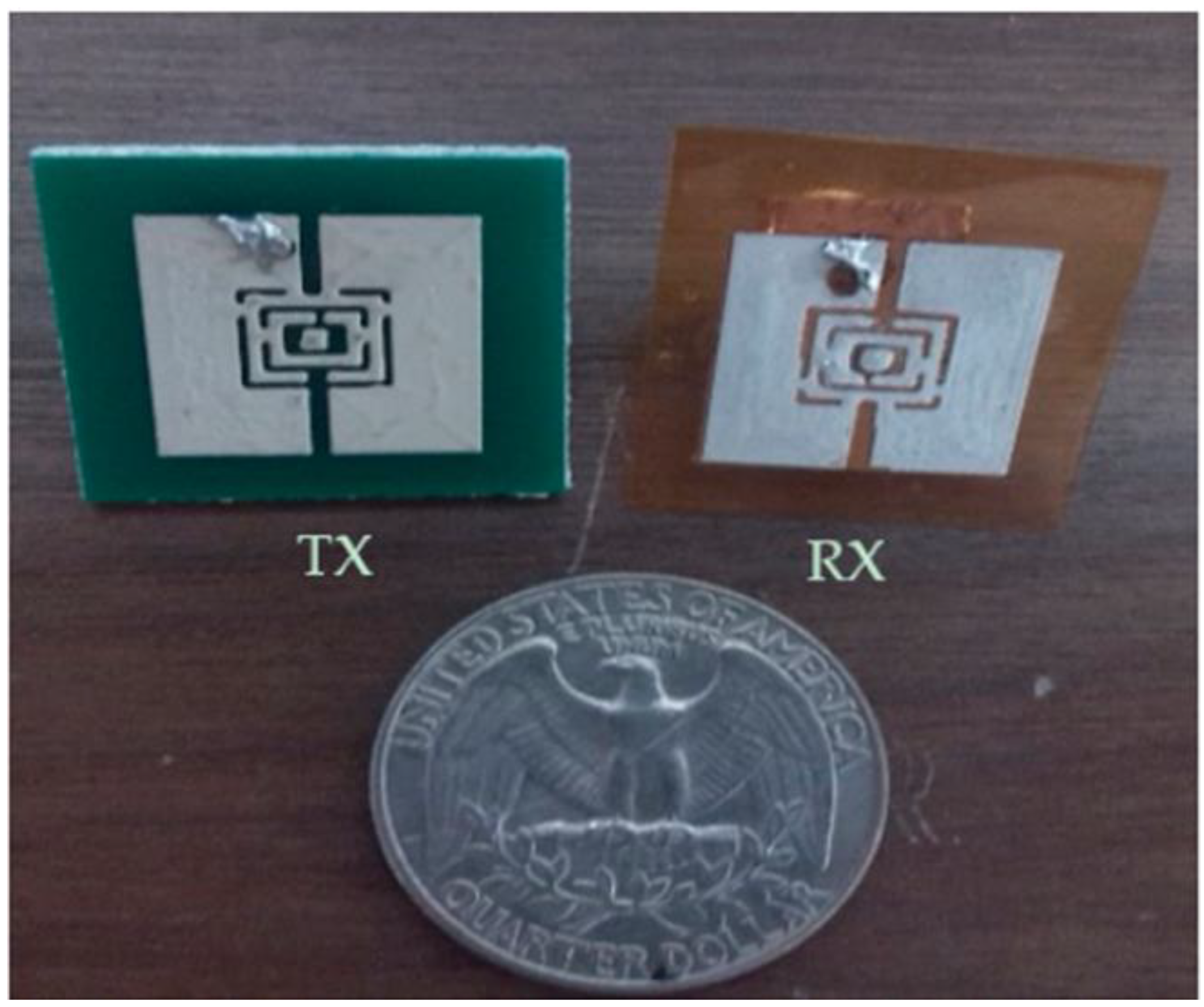
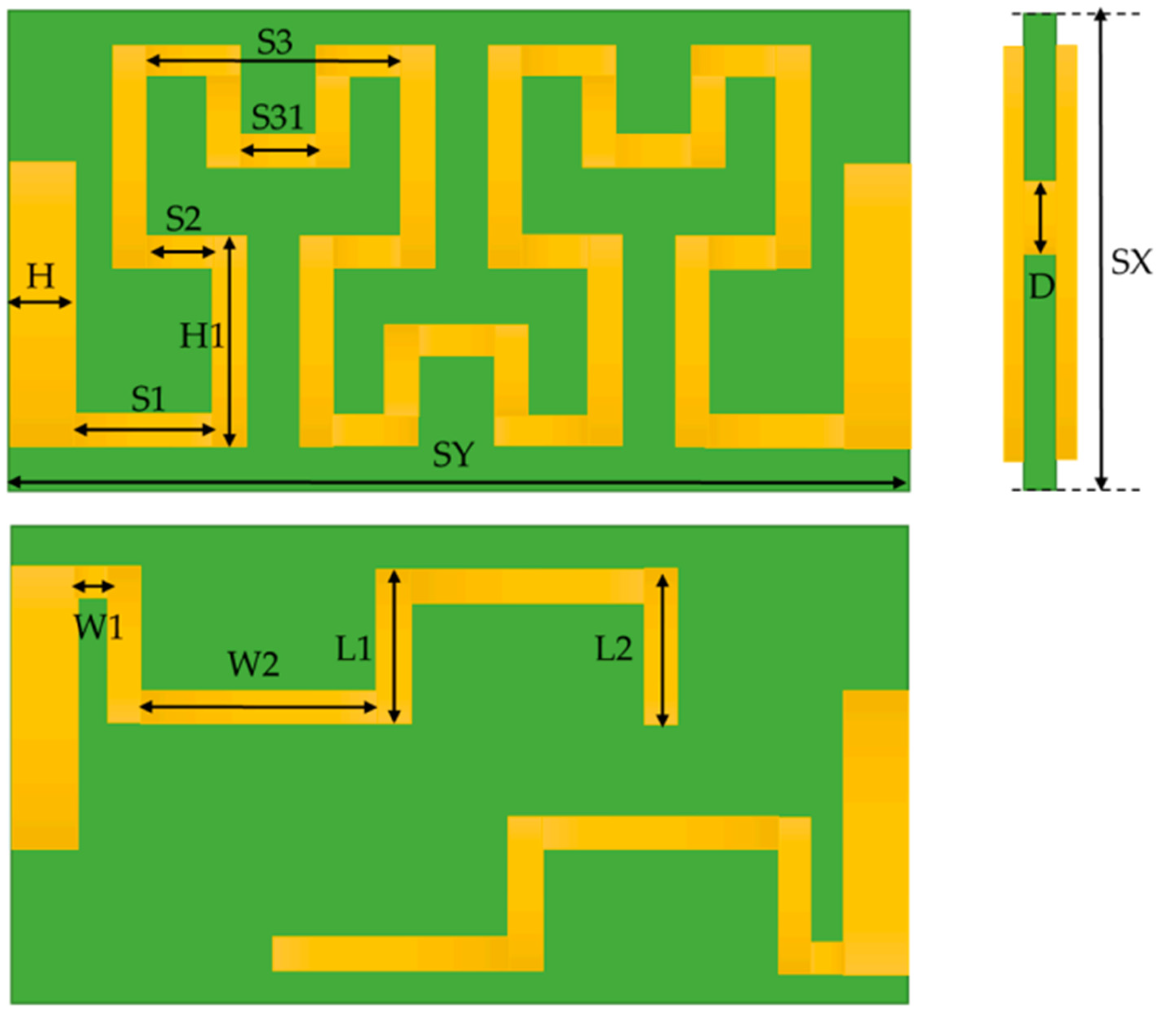



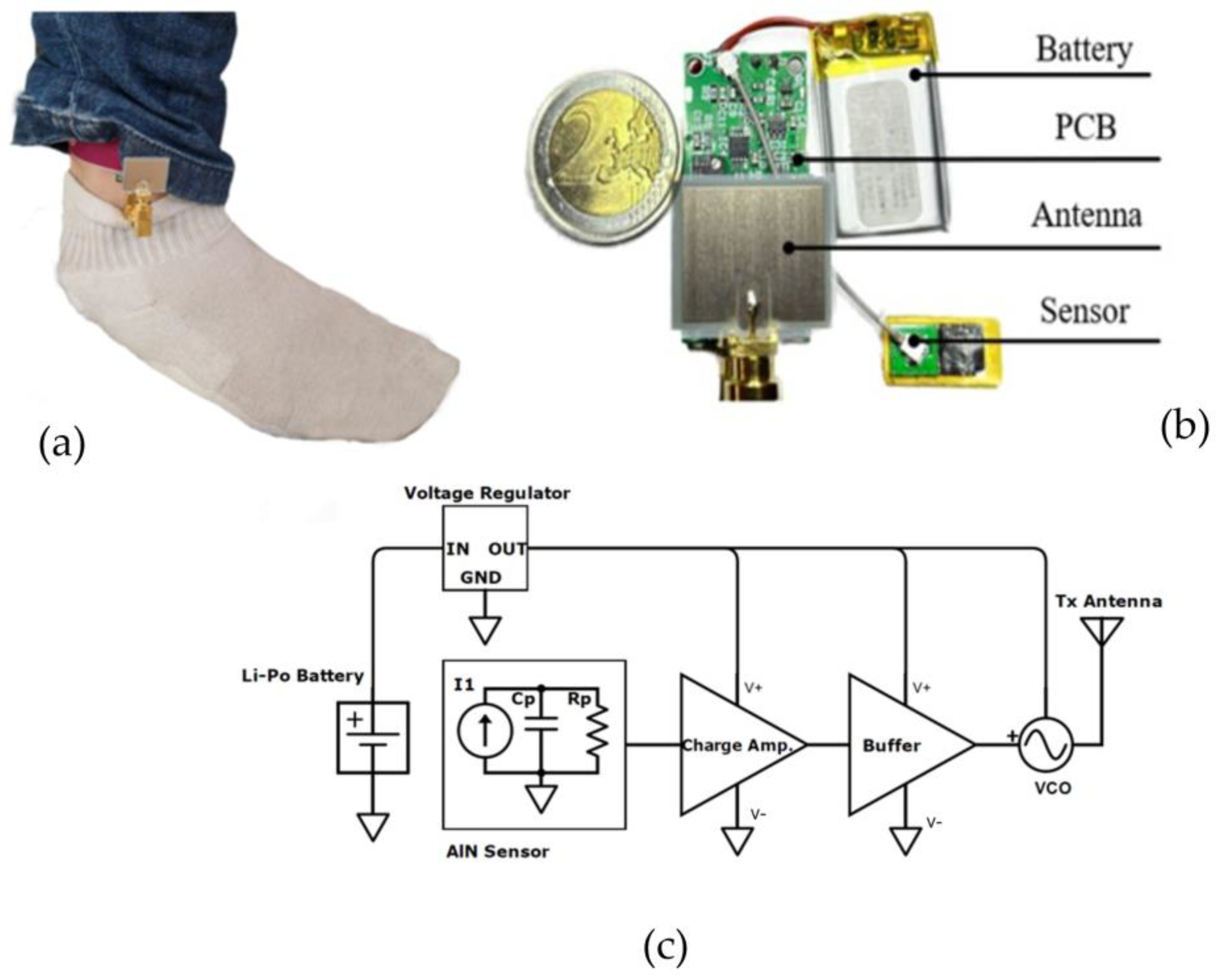



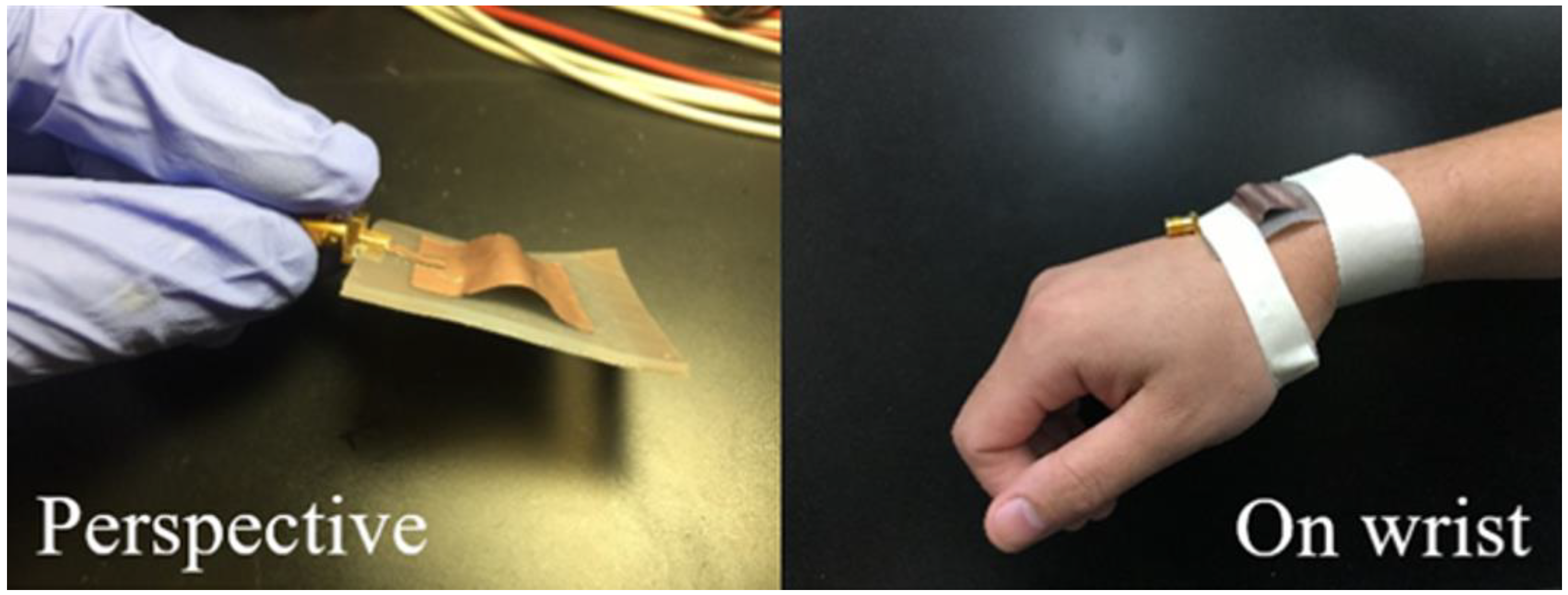

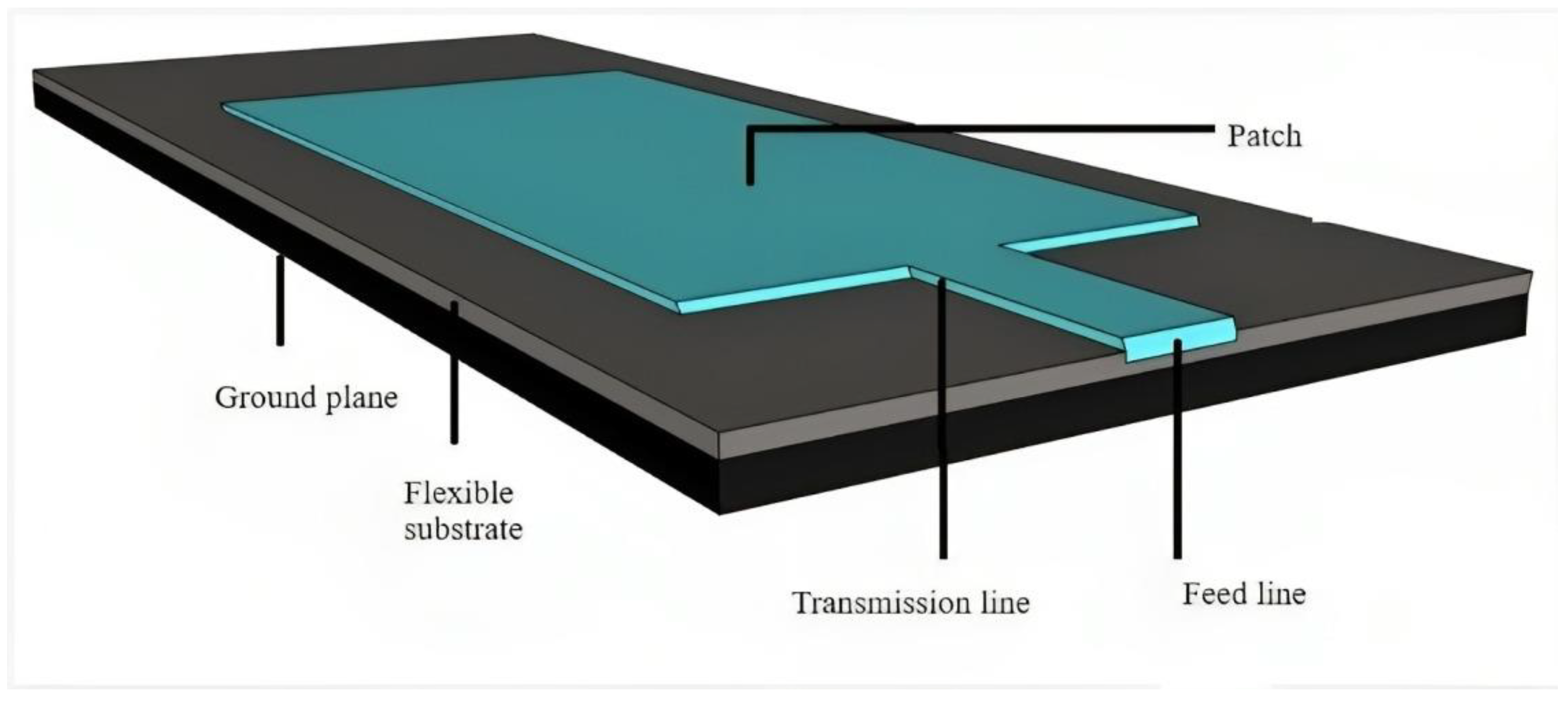
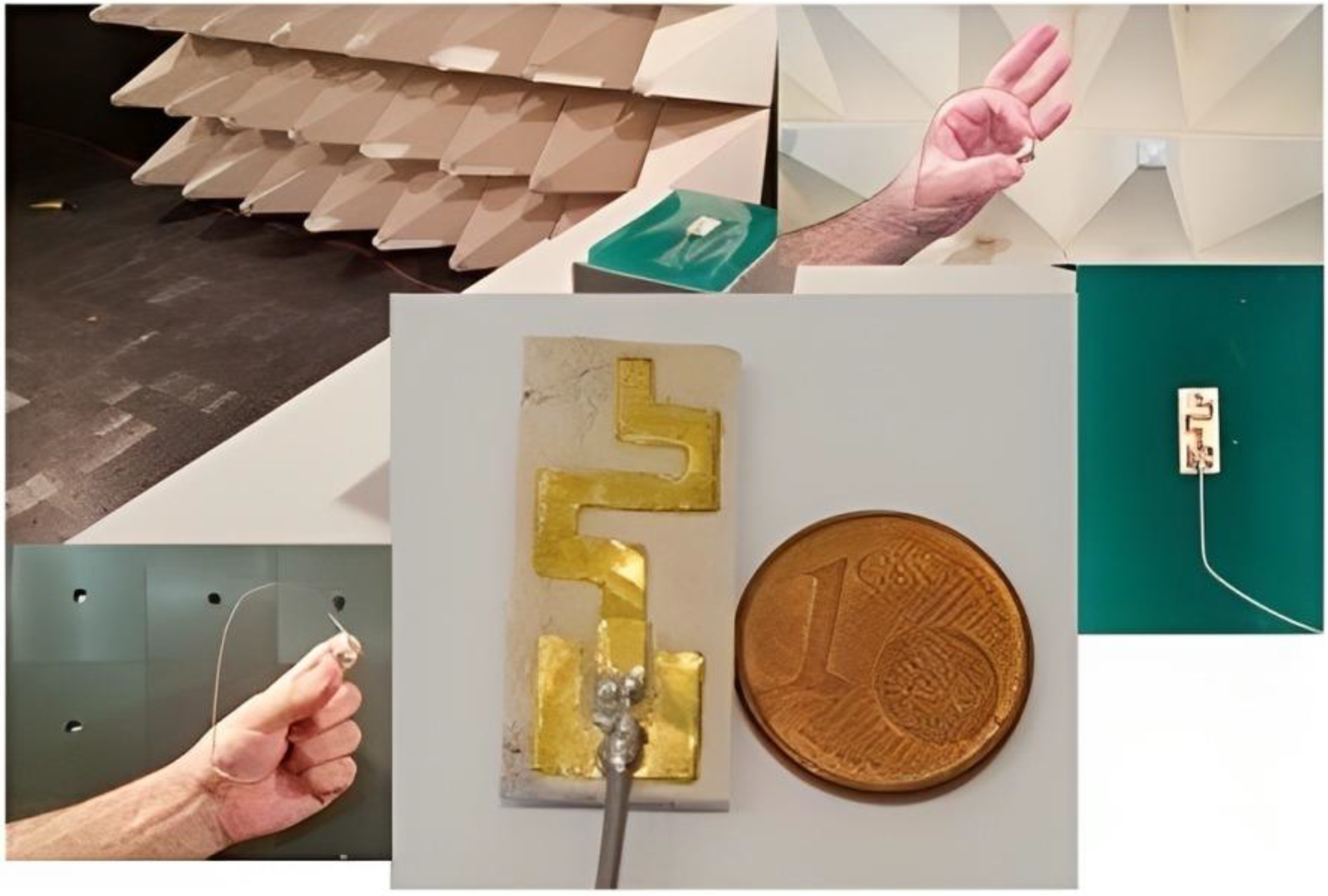

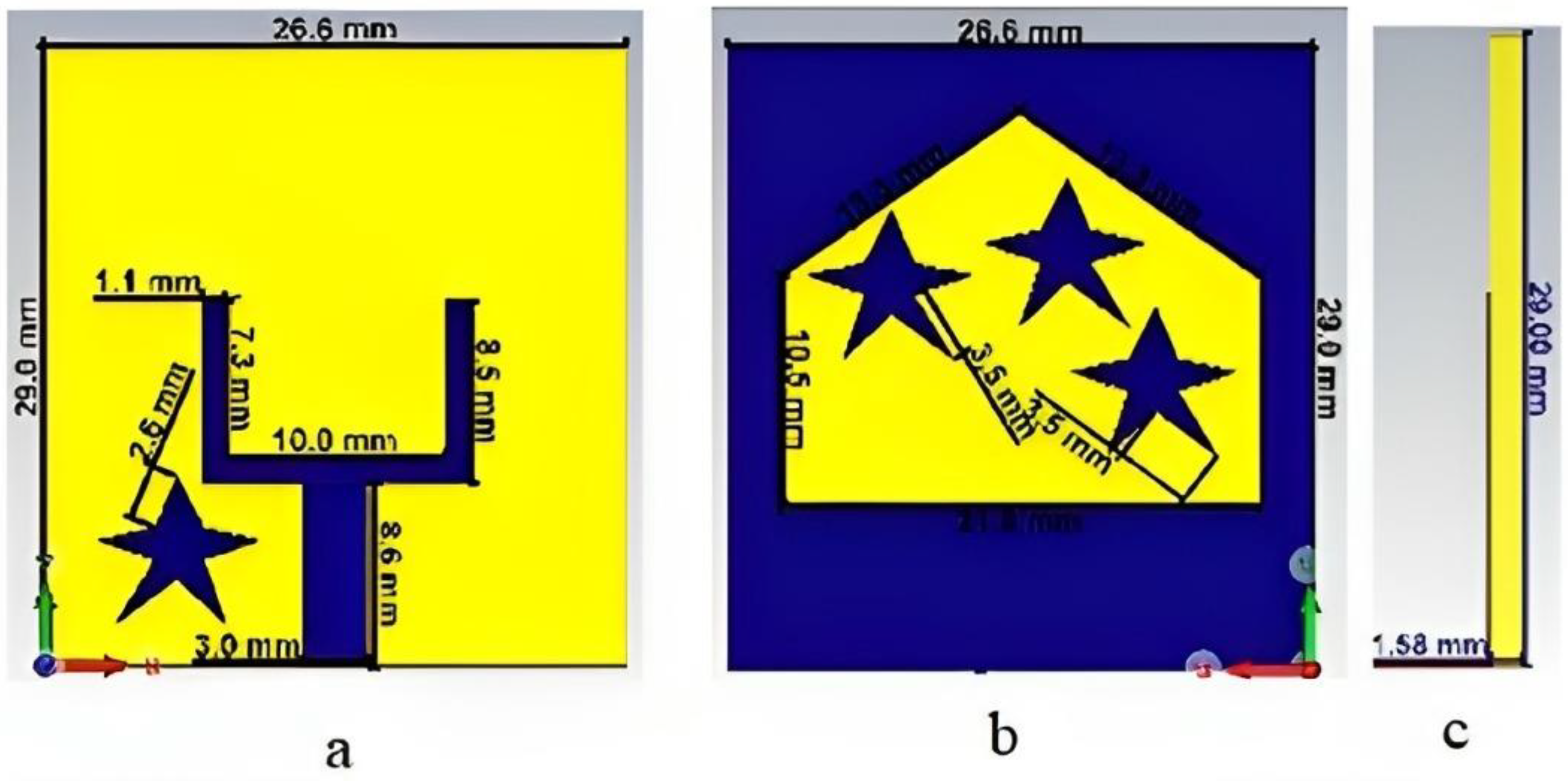



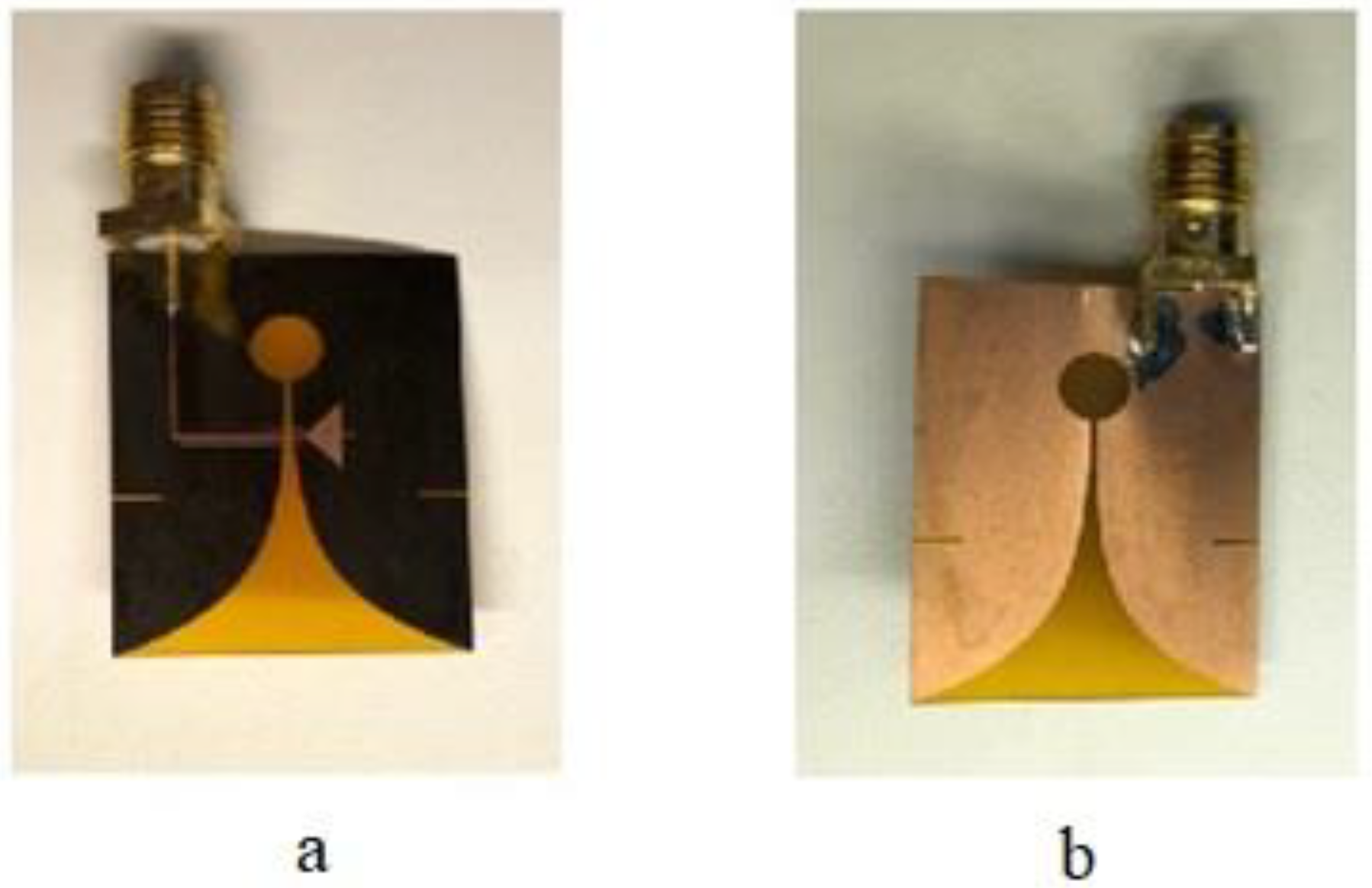
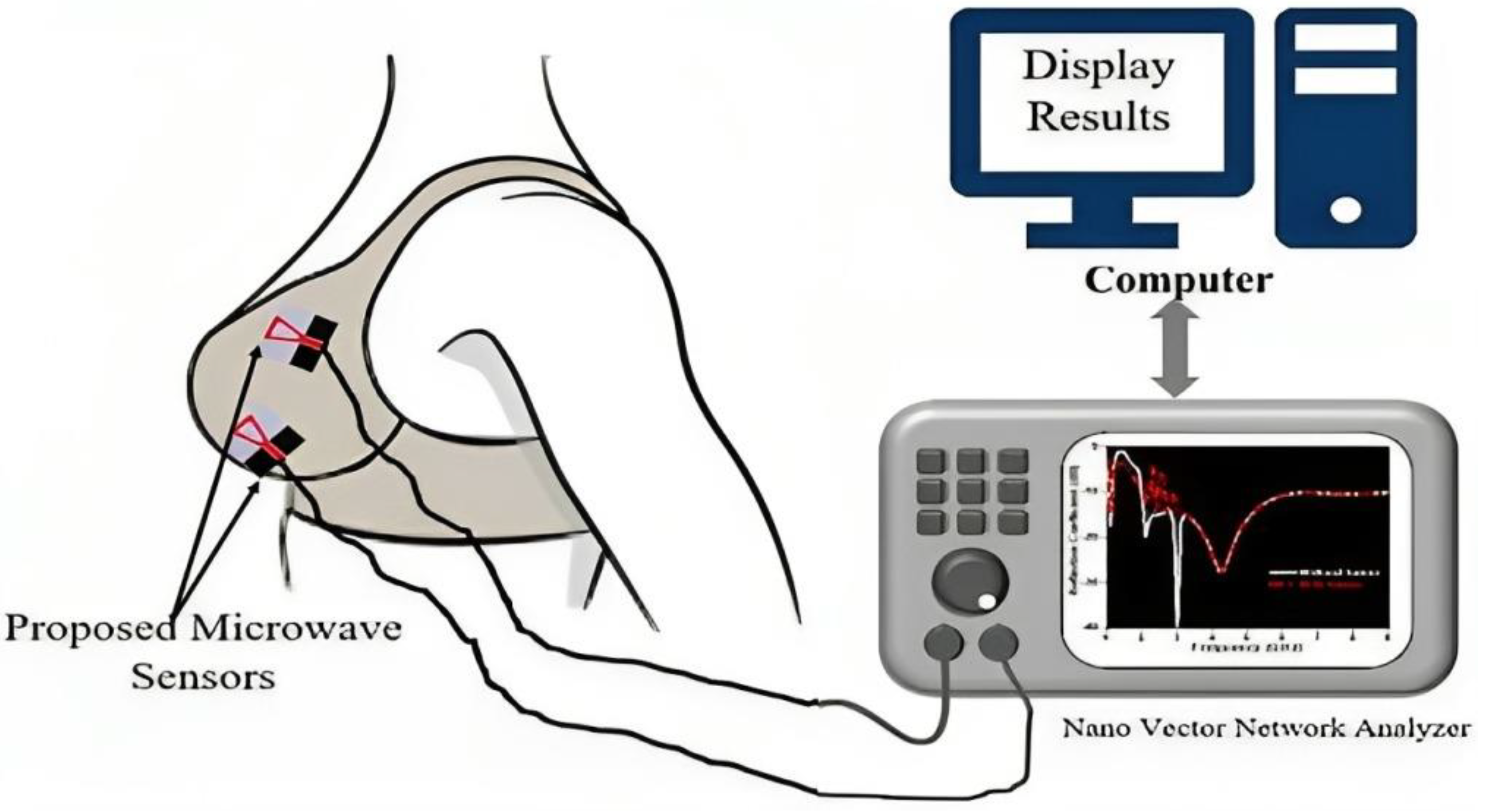

| Type of Substrate | Dielectric Loss | Dielectric Constant | Thickness (mm) |
|---|---|---|---|
| Cotton/polyester | 0.02 | 1.6 | 2.8 |
| Woolen felt | 0.02 | 1.6 | 3.5 |
| Fleece fabric | — | 1.25 | 2.56 |
| PEN | 0.025 | 2.9 | 0.125 |
| Cordura | 0.0098 | 1.1–1.7 | 0.5 |
| Felt | 0.02 | 1.3 | 1.1 |
| PDMS-MCT | 0.015 | 3.8 | — |
| PET | 0.008 | 3 | 0.14 |
| Liquid crystal polymer (ULTRALIM 3850) | 0.0025 | 2.9 | 0.1 |
| PDMS with glass microsphere | 0.014 | 1.85 | — |
| Polyimide | 0.005 | 2.91 | 0.2 |
| PDMS | 0.02 | 2.65 | — |
| PDMS with silicate microsphere | 0.02 | 2.45 | — |
| PDMS with phenolic microsphere | 0.022 | 2.24 | — |
| Paper (Kodak photo paper) | 0.05 | 2.85 | 0.254 |
| Antenna | Conductive Element | Substrate | Application | Dimensions mm3 | Resonant Frequency Bandwidth (FBW%) | Antenna Gain and Efficiency | Ref. | ||
|---|---|---|---|---|---|---|---|---|---|
| Under Normal Condition | Under Bending | Normal Condition | Under Bending | ||||||
| CPW design | Silver nanoparticle-based radiating element | Polyethylene terephthalate (PET) | Wearable navigation devices | 46 × 4 × 0.04 | 1.8 GHz and 190.5 MHz | - | 2.72 dBi and 93.33% | - | [3] |
| Rectangular | Electro-textile material | Polyester | GPS tracking devices | 40 × 30 × 1.4 | 1.575 GHz and 200 MHz | - | 3 dBi and 80% | - | [4] |
| Folding antenna with double layer | Copper | Polyimide | Wireless transmission system | 5 × 3 × 0.1 | 2.45 GHz, 5.2 GHz, 5.8 GHz | - | 1.65 dBi, 4.37 dBi | - | [11] |
| Aperture-coupled | Copper | FR4 PCB | Wearable devices | 10 × 10 × 1.4 | 2.45 GHz and 0.08 GHz | - | 6 dBi and 47% | - | [26] |
| Circular patch | Copper sheet | Textile | Body-centric wireless communication | 30 × 40 × 0.75 | 3.1–12 GHz and 7.5 GHz | 3–8 GHz and 5 GHz | 4 dBi and 80% | 3.5 dBi and 70% | [29] |
| Serpentine structures | Copper | Flexible PCB Rogers RT 5880 | ISM band | 78 × 40 × 0.254 | 900 MHZ, 2.45 GHz and 220 MHz, 570 MHz | - | 1.85 dBi, 2.2 dBi and 93%, 85% | - | [30] |
| Leaky wave antenna | Copper | Rogers RT 5880 | Vital sign detection | 95.4 × 46 × 2.9 | 60 GHz and 8 GHz | - | 24.3 dBi and 95.5% | - | [46] |
| Coplanar waveguide fed patch antenna | Copper | FR4 | Wireless application | 25 × 25 × 1.4 | 2.45 GHz, 4.5 GHz, 5.8 GHz and 0.5 GHz, 1 GHz, 0.3 GHz | - | - | - | [49] |
| Frequency selective structure (FSS) | Copper sheet | Acrylic fiber sheet | Healthcare applications | 15 × 15 | 5.45 GHz and 590 MHz | - | 3 dBi and 75% | - | [50] |
| T-shaped antenna with electromagnetic band gap ground plane | Copper | Denim | Wristband application | 35.4 × 82.4 × 40 | 2.45 GHz and 0.2 GHz | - | 7.46 dBi | _ | [58] |
| Circular patch | MXene film | Polydimethylsiloxane | Body motion sensor, 5G IoT | Diameter 25 mm | 4.8 GHz | - | - | - | [70] |
| Monopole radiator with rectangular slot | Copper | Polydimethylsiloxane composite | 24 × 28 × 1.52 | 3.125 to 13.24 GHz and 10.115 | 3.1 to 13.02 GHz and 9.92 GHz | 2 to 4 dBi | 3 dBi | [74] | |
Disclaimer/Publisher’s Note: The statements, opinions and data contained in all publications are solely those of the individual author(s) and contributor(s) and not of MDPI and/or the editor(s). MDPI and/or the editor(s) disclaim responsibility for any injury to people or property resulting from any ideas, methods, instructions or products referred to in the content. |
© 2023 by the authors. Licensee MDPI, Basel, Switzerland. This article is an open access article distributed under the terms and conditions of the Creative Commons Attribution (CC BY) license (https://creativecommons.org/licenses/by/4.0/).
Share and Cite
Venkatachalam, D.; Jagadeesan, V.; Ismail, K.B.M.; Arun Kumar, M.; Mahalingam, S.; Kim, J. Compact Flexible Planar Antennas for Biomedical Applications: Insight into Materials and Systems Design. Bioengineering 2023, 10, 1137. https://doi.org/10.3390/bioengineering10101137
Venkatachalam D, Jagadeesan V, Ismail KBM, Arun Kumar M, Mahalingam S, Kim J. Compact Flexible Planar Antennas for Biomedical Applications: Insight into Materials and Systems Design. Bioengineering. 2023; 10(10):1137. https://doi.org/10.3390/bioengineering10101137
Chicago/Turabian StyleVenkatachalam, Dinesh, Vijayalakshmi Jagadeesan, Kamal Batcha Mohamed Ismail, Manoharan Arun Kumar, Shanmugam Mahalingam, and Junghwan Kim. 2023. "Compact Flexible Planar Antennas for Biomedical Applications: Insight into Materials and Systems Design" Bioengineering 10, no. 10: 1137. https://doi.org/10.3390/bioengineering10101137
APA StyleVenkatachalam, D., Jagadeesan, V., Ismail, K. B. M., Arun Kumar, M., Mahalingam, S., & Kim, J. (2023). Compact Flexible Planar Antennas for Biomedical Applications: Insight into Materials and Systems Design. Bioengineering, 10(10), 1137. https://doi.org/10.3390/bioengineering10101137








